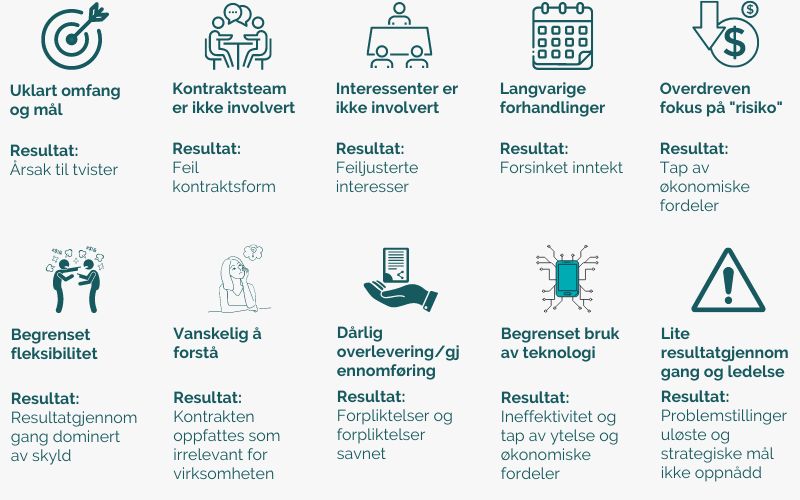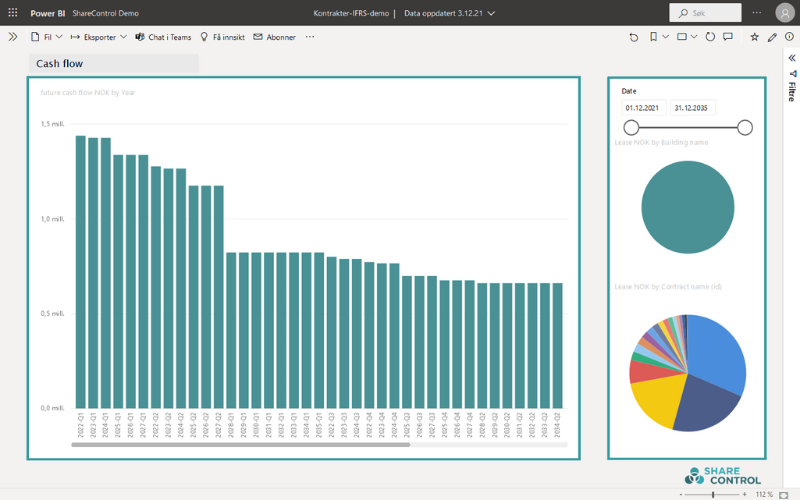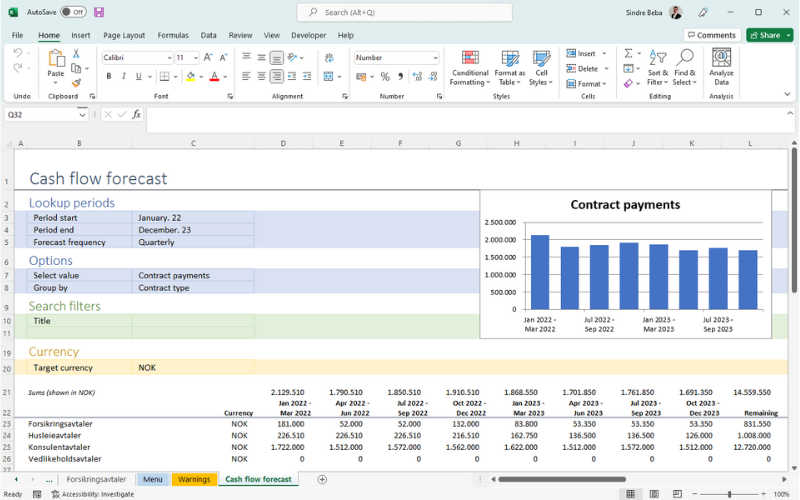What are the total costs and liabilities of your contracts? Contracts are often managed using many different spreadsheets, in different departments, with no indication of where the latest version of the contract can be found.
Artikkelens innhold
- What are the total costs and obligations of the contracts?
- Contracts cost a lot of time and money to draw up
- Lost Turnover
- Typical pitfalls in contract management you should avoid
- Get a complete overview of the future costs and obligations of the contracts
- Create a solid process for your contract management
- Simple possibilities for consolidation and cost savings
What are the total costs and obligations of the contracts?
Contracts cost a lot of time and money to draw up
Most contracts start by finding existing or similar contracts to shorten the time it takes to draft contracts. In this way, the business ensures that clauses and obligations are not lost, and the pricing is matched with the best contracts.
Drafting contracts is an essential part of many business processes, but it can be time-consuming and expensive. When starting to draft new contracts or renew old ones, there are several steps that must be taken to ensure that the contract is correct and accurate.
Overall, the drafting of contracts is a complex process that requires thorough planning, legal expertise and in-depth knowledge of the relevant industry. However, by taking the time to draft a contract thoroughly from the start, you can help avoid misunderstandings, disputes and other problems that may arise later.
Time spent on contract creation and renewal:
Across our many customers, we see clear opportunities to shorten the contract drafting process and reduce non-productive time. In short, optimizing processes and managing the contracts in one system will eliminate precious time and ensure optimal contract management with minimal risk.
Lost Turnover
Up to 9% of a company’s total annual turnover is lost each year,
– World Commerce & Contracting-studien.
Figures from World Commerce & Contracting indicate that as much as 9% of a business’s total turnover is lost each year as a result of poor contract management. This includes the employees’ time in searching for contracts, managing and preparing new ones, as well as direct financial losses as a result of missing a contract.
Typical pitfalls in contract management you should avoid
Effective contract management is critical to ensuring successful business deals and minimizing risks. Yet there are several common pitfalls that organizations can fall into when managing contracts, which can lead to unnecessary complications and loss of valuable resources. Here are ten common pitfalls in contract management and how you can avoid them:

How to avoid pitfalls in contract management
- Unclear scope and objectives: A lack of clarity around the scope and objectives of the contract can lead to misunderstandings and disputes later in the collaboration. It is crucial to clearly define all aspects of the agreement and ensure that all parties agree on expectations from the start.
- Failure to involve the contract team: Omitting key people from the contract team during the preparation or review of the contract can lead to incorrect contract forms or failure to consider important legal and business aspects.
- Lack of stakeholder involvement: When stakeholders are not involved in the contract process, this can lead to interests not being adequately safeguarded, and the contract being misaligned with the organisation’s overall goals and needs.
- Lengthy negotiations: Too long negotiations can lead to delayed revenue and delivery, which can damage the relationship with the contract partner and affect the organization’s finances and reputation.
- Excessive focus on risk: While risk assessment is important, excessive focus on risk can cause the organization to miss potential financial benefits or opportunities. It is important to maintain a balance between risk management and opportunity exploitation.
- Limited flexibility: Contracts should be flexible enough to adapt to changing conditions and needs over time. Having too rigid or restrictive contract terms can prevent the organization from adapting to dynamic business environments.
- Difficult to understand: Complex and unclear contracts can be difficult for all parties to understand, which can lead to misunderstandings and interpretation problems. Contracts should be drawn up in a clear and understandable way.
- Poor delivery: Non-compliance with contractual obligations can lead to dissatisfaction among contractual partners and loss of trust. It is important to ensure effective handover and follow-up throughout the contract period.
- Limited use of technology: Inadequate use of contract management tools and technology can lead to inefficiencies and errors in the contracting process. Organizations should invest in appropriate technology solutions to improve contract management.
- Little performance review and management: Lack of regular review and management of contract results can cause the organization to miss opportunities for improvement and risk management. It is important to establish clear processes for performance evaluation and management of contracts.
By being aware of these pitfalls and implementing digital contract management best practices, organizations can reduce risk, improve efficiency and ensure successful business deals.
Download the ShareControl Contract guide
Get insight into all the features that help you with professional contract management.
Get the guide in your inbox

Get a complete overview of the future costs and obligations of the contracts
- How many contracts does the company have and what are the total costs and liabilities?
- Find and access the latest version and changes of any contract in one system
- Simple overview and reporting of all contract costs or categories of contracts
- Get a full financial overview of your contractual obligations on both the customer and supplier side.
- Complete and accurate reporting of all contract costs and obligations
So what might the costs or opportunities of not renewing a contract or not exercising an option be? It can be compared to asking “how many trees are there in a forest?”. At least what we know is that it can lead to a lost opportunity or impose a cost on the business. There are stories that a tenant is on a long-term lease in the high-rise on Økern. All other leases have ended and the surrounding area has been rezoned for housing and other conditions. Commencement of this work is awaited until the remaining tenant. What do you think this deal is worth?
1 million kroner, 10 million, or more?
Other examples that may be relevant are a business that has forgotten not to renew its tenancy agreement. The landlord is “sitting on the fence” and waiting, because they have other plans for the property. The property must be rehabilitated to be used for other purposes. Worst case in such cases, the tenant must move out at short notice.
A rule of thumb here is that a planned move costs about one year’s rent. An unplanned move will probably cost more and who really wants to be left as the culprit who forgot to renew the agreement in this situation?
Create a solid process for your contract management
Top 10 benefits of good contract management:
- Have clearly delegated responsibility for which function and/or employee follows up on the agreement
- Have a common place to store company contracts and related documents
- Have good processes and functionality by searching for existing agreements, before new agreements are drawn up
- Possibility for efficient reuse of existing agreements and documents with the possibility of efficient sharing when preparing new ones
- Option for electronic signature
- Notification on expiry of agreement periods or renewal
- Possibility to set up activities/tasks or contractual obligations to be carried out after a given time.
- Gains an overview of the company’s financial obligations going forward.
- With good search capabilities, the company can achieve economies of scale by reducing the number of suppliers.
- Reduce costs by taking control of the company’s agreements. Don’t let the supplier take control
Contract Management Software – How to get started
Simple possibilities for consolidation and cost savings
A contract system must, in a simple and clear way, show an overview of when contracts expire, are renewed, when options must be exercised or when other contractual obligations must be fulfilled. In addition, a contract system must show the company’s total future contractual obligations, with the option to select further by type of contracts and content, locations, business units, etc.
Example of such an overview:


Tromsø municipality has agreements worth over 200 million that have expired – experts have never experienced anything like this
– I can’t think of similar cases with such a large scope and such large amounts, says lawyer Marianne Dragsten.
iTromsø revealed in an inspection before Christmas that Tromsø municipality has allowed 24 framework agreements on procurement to expire, without renewing them. The municipality has refrained from announcing the contracts again. Instead, they have continued to buy goods and services from companies.
Read the article on E24.no here
Do you have control over the total costs and obligations of the contracts?









